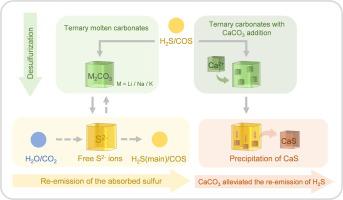Waste Management ( IF 7.1 ) Pub Date : 2021-02-15 , DOI: 10.1016/j.wasman.2021.01.029 Sihua Xu , Fu Yang , Hongyun Hu , Linxia Gao , Tongzhou Chen , Chengyang Cao , Hong Yao

|
Co-pyrolysis with oxygen-lean waste tires could improve the quality of pyrolytic oil from the bio-wastes while H2S/COS generated during co-pyrolysis process has a negative impact on the utilization of oil/syngas as well as the flue gas pollution control. Compared to traditional wet desulfurization process, high-temperature desulfurization via molten carbonates could reduce heat loss and favor the recycling of captured sulfur. Notably, small-molecule pyrolytic gases might change the species of sulfur-containing gases and promote the re-emission of absorbed sulfur from the molten salts. To fully understand the effects of pyrolysis gases (H2/CO/H2O/CO2) on molten salts desulfurization efficiency as well as mutual conversion mechanism of H2S and COS, equilibrium compositions calculations and adsorption experiments were carried out in the present study. The results showed that H2/CO had few effects on molten salts desulfurization performance and mutual conversion of H2S/COS. In contrast, CO2 and H2O had obvious adverse effects on desulfurization efficiency through the transferring of free S2− into emitted sulfur-containing gases. More specifically, only a small amount of CO2 reacted with S2− to produce COS while more S2− was converted to H2S and released from the reactor outlet when H2O was introduced. Fortunately, the impact of H2O or CO2 on molten salts desulfurization could be weakened with the addition of CaCO3 by transferring the molten free S2− into precipitated CaS. Besides, multi-stage desulfurization units connected in series and parallel were proposed and estimated, which was confirmed to show good performance to maintain the high desulfurization efficiency from the complicated pyrolytic gases.
中文翻译:

典型热解气体影响下熔融碳酸盐脱硫性能的研究与改进
与贫氧废轮胎共热解可提高生物废物中热解油的质量,而在共热解过程中产生的H 2 S / COS对油/合成气以及烟气的利用产生负面影响污染控制。与传统的湿法脱硫工艺相比,通过熔融碳酸盐进行的高温脱硫可以减少热量损失并有利于回收所捕集的硫。值得注意的是,小分子热解气体可能会改变含硫气体的种类,并促进从熔融盐中重新吸收吸收的硫。充分了解热解气体(H 2 / CO / H 2 O / CO 2)关于熔融盐的脱硫效率以及H 2 S和COS的相互转化机理,进行了平衡组成计算和吸附实验。结果表明,H 2 / CO对熔盐脱硫性能和H 2 S / COS的相互转化影响很小。相反,CO 2和H 2 O通过将游离S 2-转移到排放的含硫气体中,对脱硫效率产生了明显的不利影响。更具体地说,只有少量的CO 2与S 2-反应生成COS,而更多的S 2-被转化为H 2。当引入H 2 O时,S从反应器出口释放出来。幸运的是,通过将熔融的游离S 2-转移到沉淀的CaS中,通过添加CaCO 3可以减弱H 2 O或CO 2对熔融盐脱硫的影响。此外,提出并估算了多级串联和并联连接的脱硫装置,证实了该装置在保持复杂的热解气体的高脱硫效率方面具有良好的性能。











































 京公网安备 11010802027423号
京公网安备 11010802027423号